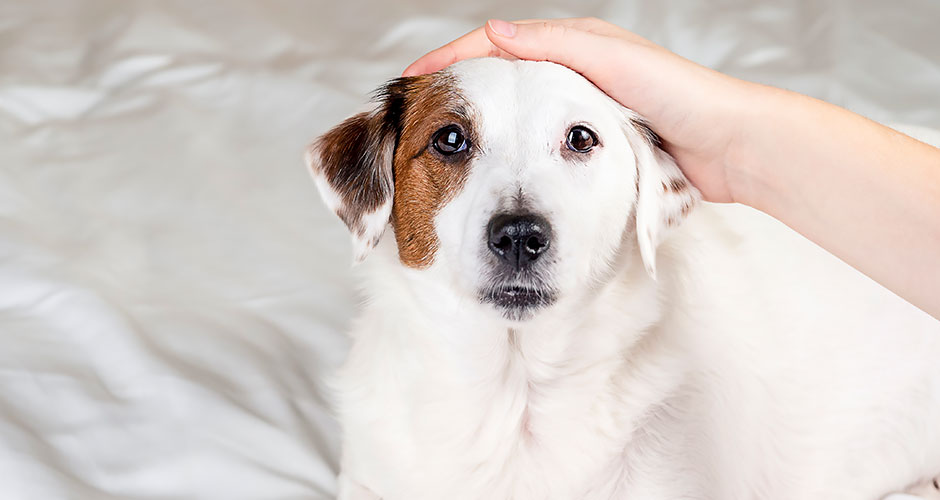What is Pancreatitis in Dogs?

Pancreatitis is the single most prevalent exocrine pancreatic disease in dogs. It usually affects dogs over five years old, dogs that are overweight, obese, and/or those prone to indiscriminate eating (e.g. getting into the trash and gorging on table scraps).
What Exactly is Pancreatitis?
Pancreatitis describes painful inflammation of the pancreas, an organ that lies between the small intestine and the stomach. The pancreas is responsible for producing enzymes to help digest food and convert it to energy.
During a pancreatitis flare-up, the pancreas produces excess enzymes, usually to help digest a fatty meal. These enzymes normally do not activate until they reach the small intestine. During a flare-up, the enzymes activate too early, and will actually begin to break down the pancreatic tissue. In essence, the pancreas begins to digest itself. The pancreas may sustain permanent scarring, lesions, and dead tissue.
Symptoms of Pancreatitis In Dogs
There are three types of pancreatitis in dogs. With acute pancreatitis, symptoms are sudden and severe, and usually warrant an emergency vet visit.
Dogs with acute pancreatitis will repeatedly vomit and/or have diarrhea, often accompanied by blood or thick, slimy mucus. Their pancreas becomes painfully inflamed, evident by a hunched over posture. You might also notice rapid breathing, a fast heartbeat, and they may refuse to eat.
With veterinary care, a dog with acute pancreatitis can make a full recovery. Some dogs will develop recurrent acute pancreatitis, going for stretches of time without symptoms between episodes.
Chronic pancreatitis, on the other hand, often goes unnoticed. Autopsies of deceased dogs have revealed signs of pancreatic flare-ups like scar tissue in 37% of dogs, including those not known to have had pancreatitis during their lifetime. A dog with chronic pancreatitis may occasionally vomit or seem to go off their food, but will generally not exhibit severe symptoms and may seem normal between flare-ups.
How is Pancreatitis In Dogs Diagnosed?
A possible acute pancreatitis episode is a medical emergency. With repeated vomiting or diarrhea, the dog may need to be hospitalized, especially if they cannot keep fluids down or seem to be in severe pain.
There is no specific test for pancreatitis. It’s usually diagnosed after other health concerns have been ruled out. Your veterinarian may test for elevated blood enzyme levels, take abdominal x-rays, use ultrasound, or, in some cases, may take a tissue biopsy to confirm the diagnosis.
How Is Pancreatitis Treated?
Under hospitalization, your dog may receive IV fluids, antiemetic or anti-diarrheal medications, pain medications, and plasma transfusion if needed. Once your dog is stable and their symptoms are under control, possibly after a few days of hospitalization, they will likely go home with pain medication and anti-emetics and/or anti-diarrheas to give as needed.
Dogs with repeated pancreatic episodes may be monitored for complications. Permanent damage can compromise the pancreas’ ability to produce enzymes and absorb nutrients from their food. Dogs with exocrine pancreatic insufficiency often lose weight despite an increased appetite. Their veterinarian may prescribe enzyme supplements to make up for reduced pancreatic function.
Many dogs can make a full recovery shortly after release from the vet hospital. Your vet may give you samples of a low-fat veterinary diet to give as your dog recovers. They may advise that you switch to your dog’s regular food, or you may need to switch to a low-fat dog food for the rest of their life. Highly digestible low-fat foods are available in prescription diets and over-the-counter foods like Wellness CORE Grain Free Reduced Fat Recipe Dry Dog Food. Treats made with lean protein, such as PureBites Freeze-Dried Dog Treats can be a part of a low fat diet.
Preventing Pancreatitis in Dogs
Certain breeds of dogs, especially Miniature Schnauzers, may be genetically predisposed for developing pancreatitis. Yorkshire Terriers, Dachshunds, and Miniature Poodles also seem to get it more often than other breeds, however, it can happen to any purebred or mixed breed dog. Dogs with chronic endocrine diseases like hypothyroidism, Cushing’s disease, and diabetes may also be at increased risk.
Obese dogs may be susceptible to pancreatitis as a result of hyperlipidemia, or high fat content in their blood. All dogs should be kept at a healthy weight under the guidance of their veterinarian. Pet parents of senior dogs, especially those of at-risk breeds, can ask their vet about switching to a low-fat senior dog food when their dog is five years of age or older.
Dogs should never be given fatty trims as treats. Bacon, poultry skin, and ham are fatty table scraps that dogs may beg for, but can put them at risk for an acute episode, even if it’s just for one meal.





